#1708 Gallery
Explore tagged Tumblr posts
Text
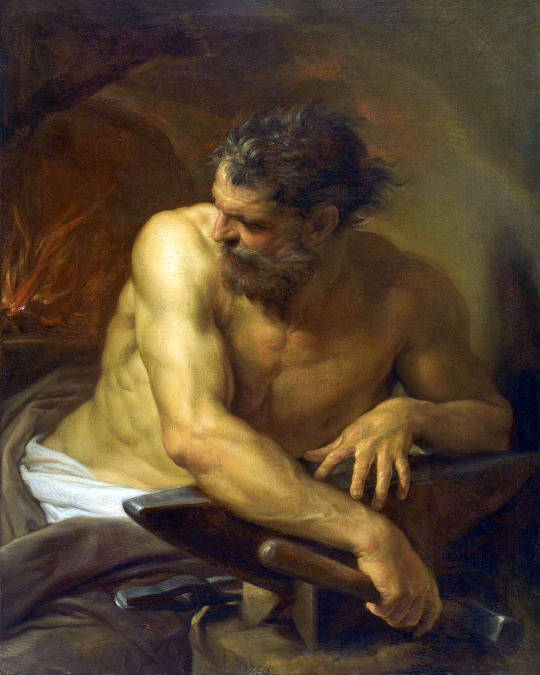
"Vulcan in His Forge", c.1750 by Pompeo Batoni (1708–1787). Italian baroque painter. National Gallery of Canada. oil on canvas
149 notes
·
View notes
Text

The Return of the Prodigal Son
Artist: Pompeo Batoni (Italian, 1708–1787)
Date: 1773
Medium: Oil on Canvas
Collection: Kunsthistorisches Museum, Vienna, Austria
Description
The biblical parable of the Prodigal Son tells of God’s mercy to a repentant sinner. Batoni depicts the return of the poor and naked son to the arms of his father, who lovingly accepts him, laying his mantle protectively around the son’s shoulders. The painter thus makes particularly clear the meaning of this parable: that the one who repents is loved more. The picture was purchased for the imperial picture gallery directly from the artist right after the painting was finished.
#religious art#painting#oil on canvas#roman culture#italian culture#pompeo batoni#new testament#christianity#bible parable#the prodigal son#italian painter#18th century painting#biblical scene#father and son#father's love#christian art
14 notes
·
View notes
Text

Emperor Francis I
Artist: Martin van Meytens the Younger (Swedish, 1695-1770)
Date: c. 1745
Medium: Oil on canvas
Collection: National Gallery of Slovenia, Ljubljana, Slovenia
Description
The portrait represents the Emperor Francis I Stephen (born 1708 in Lunéville, died 1763 in Innsbruck). In 1729 he became Duke of Lorraine, 1732 regent of Hungary and in 1736 he married the Archduchess Maria Theresa, while her sister Maria Anna married his brother Charles. After the death of Charles VI in 1740 Maria Theresa appointed her husband co-regent in the countries which she inherited, and he was also elected Holy Roman Emperor – he was crowned in Frankfurt on 4 October 1745. Francis, who is wearing the Order of the Golden Fleece, is dressed in a richly embroidered Spanish court dress decorated with lace and is wearing a hat with ostrich feathers. On the table beside him is the imperial crown, which permits a dating of the painting after the year 1745. The style of the picture is characteristic of Meytens’ ceremonial portraits (portraits d’apparat), but the fairly mechanical execution of some details suggests that assistants from the painter’s workshop collaborated on the painting.
#portrait#emperor francis i#oil on canvas#holy roman emperor#archduke of austria#habsburg-lorraine dynasty#duke of lorraine#half length#order of the golden fleece#richly embroidered court costume#hat with ostrich feathers#imperial crown#wig#oil painting#artwork#fine art#swedish art#swedish culture#martin van meytens the younger#swedish painter#european art#18th century painting#national gallery of slovenia
5 notes
·
View notes
Text

Sir Sampson Gideon and an Unidentified Companion
Artist: Pompeo Batoni (Italian, 1708–1787)
Genre: Portrait
Date: 1767
Medium: Oil on Canvas
Collection: National Gallery of Victoria, Melbourne, Australia
#portrait#18th century art#sir sampson gideon#london#english banket#18th century fashion#landscape#dog#drapery#columns#figure
5 notes
·
View notes
Text

Francis Hayman; Grosvenor Bedford
Artist: Francis Hayman (British, 1708–1776)
Date: c. 1748-1750
Medium: OIl on Canvas
Collection: National Portrait Gallery, London, United Kingdom
#group portrait#oil on canvas#painting#artist#man#standing#sitting#full length#painting easel#painter palette#studio#bust#chair#costume#cane#francis hayman#british artist#british art#european art
3 notes
·
View notes
Text


"PEREGRINE PROJECT"
by Justin Suarez
Born on a family farm in upstate New York, Justin Suarez, aka Aerosol Kingdom, has more than 20 years experience in both fine art and large scale murals. Suarez also works as a licensed bird handler at Wild Wings Animal Sanctuary near Rochester, NY and says the Peregrine Falcon once nested in the midwest but was wiped out by DDT usage by the 1960s. In 2019 Suarez had a solo show at Chicago Truborn Gallery in West Town, and painted this tribute to the work of the Chicago Peregrine Program, founded in 1985 to help reestablish Peregrines in the midwest.
LOCATION: 1708 W Chicago Ave, Chicago, IL 60622
IG: @aerosolkingdom @ChicagoTruborn @WestTownChicago
#art#streetart#mural#JustinSuarezArt#AerosolKingdom#mrprvrt#ChicagoTruborn#WestTownChicago#ChicagoMurals#PeregrineFalcon
16 notes
·
View notes
Text
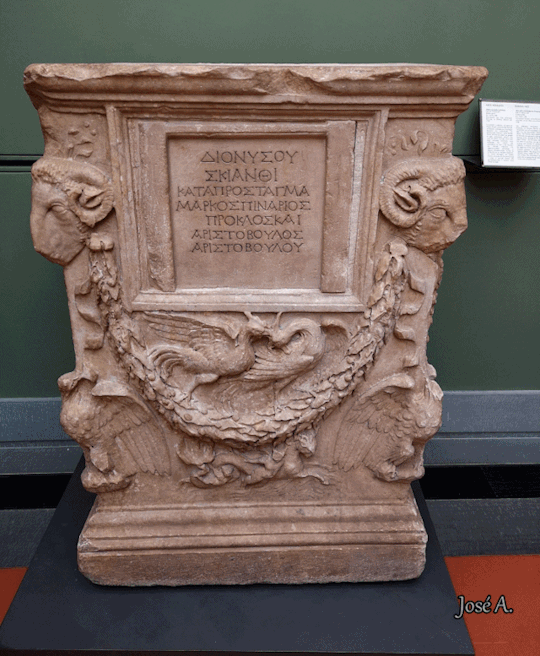
Arte romano Altar con dedicatoria a Dionisio Finales del siglo I d.C. Mármol griego Inv. 1914 núm. 988 Procedencia: anteriormente en la colección Riccardi, en la Galería desde al menos 1708.
La inscripción a Dionisio, de Pinario Proclo y Aristóbulo hijo de Aristóbulo, contrasta con la tipología funeraria del monumento. La decoración festoneada, típica de la época Flavia, delimita en el centro un grupo de gallos de pelea, en alusión a las virtudes de los muertos. A los lados, debajo de los instrumentos de sacrificio, se representan pájaros peleando entre sí o picoteando una mariposa, relacionados con la representación del alma y por lo tanto frecuentemente incluidos en representaciones de carácter funerario. La misma imagen del monstruo marino montado por dos querubines evoca las procesiones de divinidades marinas que acompañaban a los difuntos a la isla de los bienaventurados.
Información de la Gallerie degli Uffizi, imagen/es de mi autoría.
6 notes
·
View notes
Text
youtube
We caught only a snippet of this song during Ep. 1708 of Heartland during the very beginning of the gallery scene, but for some reason it grabbed my attention. The end credits were irritatingly no help, so I'm grateful for the AHA music/song finder extension that identified it with only a few short bars of music available. It's called Could Not Be Another One by:
Thomas Kenneth Varrall/Rupert Thomas Oldnall Morgan/Jonathan Joseph Hodari
Album: Cali Soul
Release Date: 2020-09-01
#heartland#Season 17#Ep. 1708#Harmony#Cali Soul#Thomas Kenneth Varrall#Rupert Thomas Oldnall Morgan#Jonathan Joseph Hodari#AHA music finder#Youtube#Could Not Be Another One
4 notes
·
View notes
Text
The Winter Palace


The first Imperial residence on the site of the Winter Palace was a wooden house in the Dutch style built in 1708 for Peter the Great and his family. This was later replaced by a stone building.
Empress Anna Ioannovna reconstructed the palace. Empress Elizabeth (Elizaveta Petrovna) decided to expand the building but completely rebuilt it instead.
The new palace was nearly complete when Catherine the Great came to the throne in 1762. The building forms a square with an interior courtyard accessed via three archways facing Palace Square. The richly decorated facades feature two levels of ionic columns, and the parapets of the building are decorated with statues and vases. The palace is 22 m high, and local planning regulations have prevented any building in the city center from rising higher than this.
Within the Winter Palace, continual improvements and revisions were made throughout the 18th and 19th centuries. In the 1780s and 1790s, a new enfilade of state rooms overlooking the Neva River was created. Under Emperor Nicholas I, the 1812 War Gallery was added.
In December 1837, a fire broke out in the Winter Palace, destroying nearly all the palace interiors. Fortunately, it did not spread to the art collections in the Hermitage. Nicholas ordered that the reconstruction of the palace be completed within one year.



Alexander II was the last of the Tsars to genuinely use the Winter Palace as his main residence. The palace was too large to be properly secured (the first attempt on Tsar Alexander II's life the year before had been a bomb that damaged several rooms in the palace and killed 11 guards). Alexander III and Nicholas II both set up their family residences at suburban palaces. Nonetheless, the Winter Palace was still used for official ceremonies and receptions. A spectacular masked ball commemorating the anniversary of the reign of Tsar Alexey Mikhailovich (1646-1676), held in 1903, was the last major event hosted by the Imperial family at the Winter Palace.



In 1917, after Nicholas II's abdication and the February Revolution, the Winter Palace became the seat of the Provisional Government under Alexander Kerensky. Against this authority, the Bolsheviks stormed the palace in October of the same year. A portion of the Winter Palace's riches were ransacked, including the enormous Imperial wine cellars (although the looting did not extend to the Hermitage).
The Winter Palace was declared part of the State Hermitage Museum in 1917. Although the initial Bolshevik policy was to remove all Imperial symbols from the palace and use the premises as a museum of the Revolution, the restoration project of the 1940s and 1950s, which followed further extensive damage to the building during the Siege of Leningrad, saw the beginning of an ongoing process to return the Imperial splendor of many of the palace's rooms. The State Rooms of the Winter Palace now form one of the most popular sections of the Hermitage.



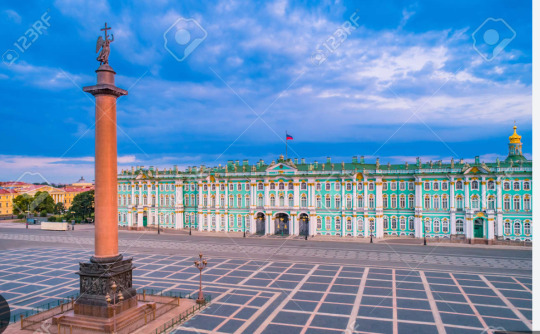
4 notes
·
View notes
Text
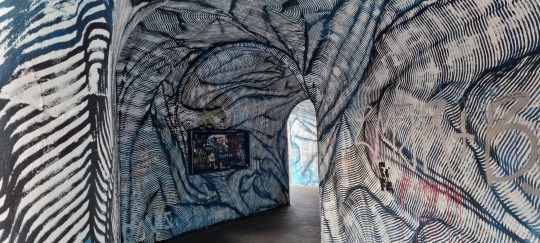

LOMENÁ GALLERY, Denisova 284/30, 779 00 Olomouc, Czechia The Lomená galerie, literally Broken Gallery, is a cultural space in Olomouc, located in the so-called Lomená Passage in a Baroque building from 1701–1708, the former school building of the Jesuit University, in the historical place where the New Gate once stood as the boundary of Olomouc's forecourt and the burgher town. Lomená galerie je kulturní prostor v Olomouci, který se nachází v tzv. lomeném průchodu v barokní stavbě z let 1701–1708, bývalé školní budovy jezuitské univerzity, v historickém místě, kde stávala kdysi Nová brána jako hranice olomouckého Předhradí a měšťanského města. Lomená galerie
#Lomená Gallery#Denisova#Olomouc#Czechia#Lomená galerie#Broken Gallery#cultural space#Lomená Passage#Jesuit University#kulturní prostor#lomený průchod#Jezuitská univerzita#Olmütz#Оломоуц#Ольмюц#Ołomuniec#Morava#Moravia#Moravie#Mähren#Моравия#Morawy#Česká republika#Czech republic#Tschechien#Tschechische Republik#République tchèque#Tchéquie#Чехия#Чешская Республика
4 notes
·
View notes
Text

“Portrait of Richard Milles” c.1760s, by Pompeo Batoni (1708–1787). Italian painter. The National Gallery, London. oil on canvas
19 notes
·
View notes
Text

















got the opportunity to take over 1708 Gallery for their summer 5x5 program. typically its 5 artists getting 2 weeks apiece in the gallery, but we chose to forgo the usual and team up on a group installation we dubbed "Den of Ingenuity." Taking 5 vastly different styles and practices, we mashed them up to create a third space that felt like someone dropped a living room in the middle of an art gallery. And for almost 3 months we packed the schedule with programming. Movie screenings, figure drawing, DJ sessions, and art swap meets. Looking forward to finding more opportunities to repeat this concept.
0 notes
Text

Kaiser Franz I. Stephan von Lothringen
Artist: Martin van Meytens (Swedish-Austrian, 1695–1770)
Date: c. 1745-1765
Medium: Oil on Canvas
Collection: Belvedere Gallery, Belvedere Palace, Vienna, Austria
Francis I, Holy Roman Emperor
Francis I (Francis Stephen; French: François Étienne; German: Franz Stefan; Italian: Francesco Stefano; 8 December 1708 – 18 August 1765) was Holy Roman Emperor, Archduke of Austria, Duke of Lorraine and Bar, and Grand Duke of Tuscany. He became the ruler of the Holy Roman Empire of the German Nation, Austria, and Tuscany through his marriage to Maria Theresa, daughter of Emperor Charles VI. Francis was the last non-Habsburg monarch of the Empire. The couple were the founders of the Habsburg-Lorraine dynasty, and their marriage produced sixteen children.
#portrait#painting#full length#martin van meytens#european art#european monarch#francis I#holy roman emperor#german nation#austria#tuscany#european#costome#stockings#table#indoor#red chair#pillar#wig
1 note
·
View note
Text
Unveiling the Timeless Charms of 1708 House: You’re Historic Getaway in Southampton
Nestled amid the picturesque landscapes of Southampton, New York, stands a hidden gem that transports its visitors to a bygone era of elegance and grace. The 1708 House, a historic boutique bed and breakfast, offers not just accommodation but an enchanting journey into the rich tapestry of Southampton history. With its warm hospitality, romantic ambiance, and prime location on Main Street, this establishment has become a beacon for travelers seeking an unforgettable experience.

A Glimpse into History
Stepping into the 1708 House is akin to stepping back in time. This meticulously restored historic inn dates back to the early 18th century, a testament to the charm and character of a bygone era. The well-preserved architecture, period furnishings, and intricate details of the house whisper tales of centuries past. It's not just a place to stay; it's an immersion into the very essence of Southampton history.
The Epitome of Romantic Getaways
For couples in search of a romantic escape, the 1708 House offers an idyllic retreat. The charming rooms, each adorned with antique decor, create an intimate ambiance perfect for kindling or rekindling romance. Imagine sipping morning coffee together in a quaint courtyard, enveloped in the serenity of the surroundings. As the sun sets, the soft glow of candlelight illuminates your evening, promising cherished memories to last a lifetime.
Prime Location, Unrivaled Experience
Situated on Main Street, the 1708 House enjoys a coveted location that puts the very best of Southampton at your doorstep. Main Street is more than just a thoroughfare; it's a hub of cultural delights, boutique shopping, and exquisite dining. Stroll hand in hand with your loved one, exploring art galleries, charming boutiques, and the vibrant local scene. Return to the comfort of the 1708 House after a day of exploration to unwind in its peaceful oasis.
A Restful Haven
Amid the hustle and bustle of life, the 1708 House stands as a tranquil haven. Its inviting rooms offer respite from the demands of the outside world. Sink into plush beds adorned with crisp linens, and let the worries of the day melt away. The innkeepers' commitment to your comfort ensures that every detail is attended to, allowing you to truly relax and rejuvenate.
Crafting Memories
The 1708 House isn't just a place to lay your head; it's a canvas for crafting memories. From intimate weddings to milestone celebrations, this historic bed and breakfast provides an exquisite backdrop for life's special moments. The meticulously maintained grounds, adorned with colorful blooms, offer a charming setting for outdoor gatherings. The experienced staff works closely with guests to bring their visions to life, ensuring that every detail is curated to perfection.
A Welcoming Embrace
The heart and soul of the 1708 House lies in the warmth of its hospitality. The innkeepers extend a genuine welcome, creating an atmosphere that feels more like visiting old friends than staying at Boutique Inn. Their passion for history and dedication to preserving the legacy of the house shine through, enriching your experience with insights and stories that breathe life into its walls.
In conclusion, the 1708 House in Southampton, New York, is more than a place to rest; it's a destination that envelopes you in the embrace of history, romance, and timeless charm. From its historic significance to its prime location on Main Street, every facet of this boutique bed and breakfast contributes to an unforgettable stay. Whether you're seeking a romantic getaway, a journey into the past, or a serene escape, the 1708 House invites you to step through its doors and create your own story within its walls.
Contact details
USA +1 631-287-1708
Visit Our Website: https://1708house.com/
0 notes
Text

Portrait of John Scott of Banks Fee
Artist: Pompeo Batoni (Italian, 1708-1787)
Date: 1774
Medium: Oil on Canvas
Collection: National Gallery, London, United Kingdom
Description
Portrait of a Man is a 1774 oil-on-canvas portrait by the Italian painter Pompeo Batoni, now in the National Gallery, London. It is traditionally identified as John Scott of Banks Fee near Stow-on-the-Wold, though this is not yet verified. Banks Fee was bought by a man named John Scott in 1753 and Charles Burney records a "Mr Scott" in Rome in 1770, the time and place where Batoni was active. However, it is not yet known if the two Scotts are one and the same and whether he is definitely the subject.
#portrait#man#john scott of banks fee#pompeo batoni#italian painter#cane#hat#costume#18th century painting#european#oil on canvas
2 notes
·
View notes
Text
29. Dana Davenport & LaRissa Rogers
Dana Davenport and LaRissa Rogers discuss their experiences as Black and Korean artists and how their research and life experiences have led them to work with specific materials, motifs, and ideas. They discuss their work through the framework of family history, belonging, and Black-Asian futurity/solidarity.

Dana Davenport (DD): Hi LaRissa! I'm so excited to chat with you about our practices, expressions of identity, and interconnected histories. I came across your work a few months back while doom scrolling on Instagram. Unlike most days, I can say it was productive as it brought me to your work. I was thrilled to come across another Black and Korean artist working within similar mediums (sculpture, performance, and video). I was equally as excited simply to meet another Black and Korean person. I asked our mutual friend, TJ, to introduce us and now here we are. As I began to dive deeper into your work, I discovered so many throughlines in how you utilize the body, draw from familial history, and use specific materials to dissect identity. Perhaps, as a place to start off, can you talk a bit about your relationship to the materials that you're currently working with?
LaRissa Rogers (LR): Hi Dana! I am very excited you extended the opportunity for this correspondence. Similarly, I found your work doomscrolling on Instagram a few years back, and I was immediately a fan. It was exciting to see someone working through their identity, familial history, and materiality as a Black and Korean femme. Then a few years later, I received a lovely email from TJ, mentioning you were in LA and introduced us! It was such a great surprise, and I am so excited to start this relationship and pick your brain! Haha.
For me, material history is the easiest way to dissect and draw parallels to identity formation and larger narratives around diaspora, migration, belonging, violence, labor, care, etc... At the moment, I am working with porcelain, sugar, and soil. I began working with soil in 2019, almost as a default. I had just finished a project, “We’ve Always Been Here, Like Hydrogen, Like Oxygen,” which was a performance on the Richmond slave trail. The performance consisted of me washing my body with oranges as a ritual of self-care. At the time, the BLM uprisings were happening, Breonna Taylor was assassinated, AAPI hate was high, and I was paralyzed by the similarities in the political landscape of LA in 1992 and the current times. For me, oranges were a direct link to the Latasha Harlins murder and the erasure/silencing of Black women and girls. But, this case is very layered and complex. It's about anti-blackness, fear of others, misinterpretation, the legacy of slavery and policing, the corrupt judicial system..and I could go on. But, essentially, we have to look at this event holistically and consider all of the ways internal and external anti-blackness showed itself in violent ways. I wanted to use the Richmond slave trail and the African burial grounds to think through how we are implicated through landscape and history. It was also important for me to link temporalities and draw out similarities between these three moments in time. This performance was an outcry, an attempt at asking: “what does it mean for Black women and girls to be protected and cared for?” The title of the piece stems from a Dionne Brand quote, when the descendants of enslaved people meet their ancestors in a slave castle – where the ancestors say in awe: “you are still alive, like hydrogen, like oxygen.”
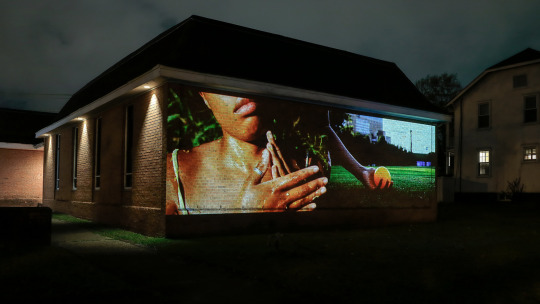
LaRissa Rogers, We've Always Been Here, Like Hydrogen, Like Oxygen, 2020. Double channel video Installation, 7min 22sec. Installed at Resurrection Lutheran Church, Richmond, VA.In Light 2020: Safety and Accountability. Photo Courtesy of 1708 Gallery. Photo by David Hale.
LR: This work leads me to work with soil. I was in online grad school at the time and had just moved back to Virginia (where I was born and raised) and did not have a studio. So, naturally, the landscape became that for me. As we already know, Virginia is a fraught place. I lived in Richmond for several years while attending undergraduate school and stayed a bit after. But, I was born and raised in Charlottesville, VA. Reading the news one day, I encountered this article about Pen Park. I grew up going to this park when I was young. My mom would take me to play at this park while we waited for my brother to get out of school. My father golfs there as well. But, Pen Park used to be an antebellum plantation. At Pen Park, there is a golf course, and on the golf course, there are unmarked slave graves. This place is not acknowledged. Around this time, I was also thinking heavily about monuments. The confederate monuments in Richmond were getting pulled down, and it seemed like every major city around the world was having conversations about their relevance and relationship to collective memory.
In Christina Sharpe’s In The Wake, On Blackness and Being, she speaks about residence time. She describes the residence of sodium held within the body being 260 million years, in relation to the enslaved Africans who were thrown, jumped, or dumped in the ocean during the middle passage. This residence time allows one to begin to think through the terms in which we understand the conditions of Black suffering. In contrast to water, the body takes approximately 200 years to return to dust when buried in the ground. As the nutrients of the body disintegrate back into the earth, how can thinking through residence time in the soil help us understand what it means for Black people to suffer when suffering is the ground?
Given how closely Black people are indexed to death, soil also holds the capacity to speak to regeneration. Historically, it is a place of Black resilience and possibility through geophagy, slave gardens, revolts, and the migration of African plants and foods to the Americas by way of women smuggling seeds in their hair during the middle passage. Soil is a living archive and speaks to the nonlinear nature of time. Saidiya Hartman’s theory of temporal entanglement questions how we narrate historical time when thinking about the afterlife of slavery. She calls us to examine the intersections where the past, the present, and the future, are not discretely cut off from one another, but rather, we live in the simultaneity of that entanglement. The ephemeral nature in which many traditions, stories, and ways of knowing are preserved in Black, Brown, and Indigenous communities becomes visible in intangible ways due to colonization. Methods of remembering that cannot be held but are protected through and within the people themselves.
Using this as a framework, I did a few projects with soil, Virginia soil, and soil from different locations with historical relevance. You can see my attention to soil in the works “Ode to soil” “A Poetic of Living” and “On Belonging: The Space In Between.” As a material, soil does a lot for me.
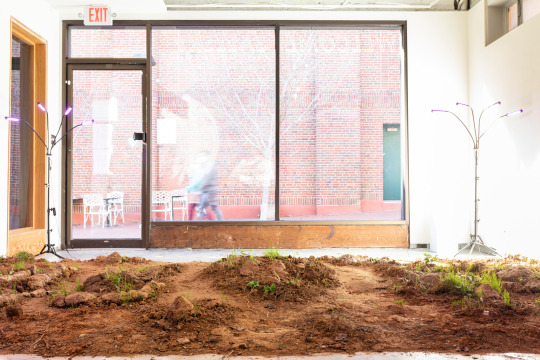
LaRissa Rogers, A Poetic of Living, 2021. installation, Dimensions Variable, Soil from Pen Park and Farmington Country Club, Celosia, Fungus, Oxygen, Light, Care. Photos courtesy of Welcome Gallery. Photos taken by Stacey Evans.
LR: I am also working with porcelain and sugar. I began researching sugar after my project with oranges in 2019. We are all familiar with the sugar trade and its relationship to the transatlantic slave trade in the Americas and Global South. But I am also interested in how sugar functions today within the US context. It disproportionately affects Black and Brown communities – operating similarly to that of the plantation system. My family has a history of diabetes and sugar-related complications. Alternatively and historically, sugar is a commodity that has connected all four continents. The first significant wave of Korean laborers worked in the sugar plantations in Hawaii. There is also an expansive history of coolie workers and indentured servitude related to sugar in the US. In the 18th and 19th centuries, sugar pastillage was used by European royalty to create table displays for admiration, then consumed at the end of the night. The sugar sculptures became a status symbol often, displaying racialized and exoticized images. With the decline in sugar’s value and the impossibility to preserve the sugar sculptures for long stints of time, sugar pastillage was substituted for porcelain. This porcelain is commonly coveted within upper-class white homes as "fine china.”
Right now I am delving deeply into Anne Cheng’s work around ornamentalism. In yellow feminist theory, the Asiatic subject becomes ornament. Whereas in Black feminist theory, the Black body is bare life, these relationships are important to me and start to touch on the complexities of my afro-asian identity and how I experience violence navigating within a world that prioritizes skin. Thinking through these two materials and their relationship to the body, the mouth, the act of hunger, the ornament – become what Anne Cheng describes as the divergence between Black flesh and Yellow ornament. Using the scars from being whipped on Sethe's back in Toni Morrison’s Beloved as an example, Anne Cheng articulated that the flesh that passed through objecthood needs ‘ornament’ to get back to itself.” This is where ornamentation, particularly the chinoiserie pattern I am researching right now becomes a nuanced symbol and not just a decoration. There are moments when the wound needs ornament – we see this a lot in Black material culture through the use of gold, chains,” swag” –but there are also many times when the wound and the ornament cannot be compared.
The chinoiserie pattern, which the blue willow pattern stems from, was something I grew up around. My mom is Korean, born in Seoul. She was a war baby and orphan brought to the US by a Black soldier stationed in Seoul during the Vietnam war. It is crucial to realize the complexity of her story on a macro and micro level. Her story is a byproduct of US imperialism in Korea, GI babies, and the beginning of Korea's large adoption project that set legislation in place to rid the country of “unpure” Koreans. At this time, there was also sanctioned prostitution of Korean women for the American military resulting in a wave of Korean mothers and American fathers, who eventually moved to the US.
For my mom, once brought to the US at age four, her adoption requirements were never fulfilled, so she remains stateless. She was raised by my grandfather's mother in a poor Black household in Madison, VA. My father, a Black man, was similarly raised in a very poor neighborhood in Newport News, VA. Growing up, my mom decorated the house in this blue and white greenware. I was unaware of the history of blue and white greenware or chinoiserie, but I was always curious about this decision. I read it as a representation of a heritage or place (Korea) that she no longer had access to. My new body of work delves into this pattern, chinoiserie -- a pattern adopted by the Europeans as an idyllic and exoticized interpretation of Asian people and life. I am interested in its relationship to diasporic distance, belonging, and everyday violence that upholds white supremacy. I am also interested in this conversation surrounding the influences, perceptions, and interpretations one performs in the creation of self. The way this pattern, a distant interpretation, a fantasy of others, became removed from its violent history within the home, assumed, and merged with a Black interior aesthetic to create a new language – one that exists in the in-between, the liminal.
For me, the liminal is parallel to notions of authenticity when working with this pattern and being mixed-raced. One should always question their perceptions of purity and outside influences of authenticity. Where does culture begin? With the start of global trade in the 18th century and the rise of capitalism — cultural symbols and objects were constantly being assumed, consumed, merged, adopted, and recontextualized. It’s a violent process. But, in specific situations, this cannibalization or hybrid transformation impacts intersecting identities and allows the violent collision to become something greater than just the violence—especially for those who have been exiled. Edward Glisssant calls this “opacity” – or a lack of transparency for and toward the other– that can “coexist and converge weaving fabrics.” He states that “To understand this truly, one must focus on the texture of the weave and not on the nature of the components.” For me, opacity has become a strategy for engaging cultural multiplicity and diasporic imagery of resistance and power. Opacity allows you to be fully seen without being owned. It allows you to occupy spaces you may not be seen as a member of. Opacity and what Fred Moten coins as “fugitivity”-- “a desire for and a spirit of escape and transgression of the proper and the proposed…a desire for the outside, for a playing or being outside, an outlaw edge proper to the now always already improper voice or instrument”-- creates portals for seeing and being seen.
Also, a fun fact, the chinoiserie pattern was used by the founding fathers (Thomas Jefferson, James Madison, etc..) to reinforce symbols of enlightenment that uphold race within architecture commonly found in Virginia...
But, I am curious and would like to ask the same question. What materials are you working with right now, and how does your background inform those decisions?
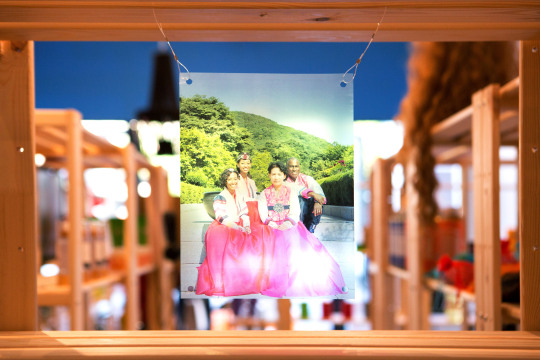
Dana Davenport, Dana’s Beauty Supply ~and relaxation space~ (detail of family photo)
, 2021,
Installation at Recess Art
, Photography by Mary Kang
DD: Wow, thank you for so eloquently sharing your relationship to the materials you’ve been working with. Your use of material and the histories that they hold really resonate with me. As you know, I was born in Newport News, Virginia and raised in Seoul, South Korea. Although Virginia is not a place that I’ve spent much time in, much of my dad’s family is scattered throughout the Virginia area so it’s where we meet for family reunions and such. As a kid, I went through many different phases. One of those phases was an obsession with America (and therefore Virginia) and claiming my Americanness to my friends who also went to school on the military base in Seoul. It sounds silly to want to “prove” your Americanness while literally going to school on an American military base. But, you know how kids can be. They’ll find anything to pick on someone about. Haha. What I didn’t know or understand at that time is how fraught of a place Virginia was and still is. The way that Virginia existed in my mind as a place that validated my belonging even though I was thousands of miles away, versus the reality that even if I lived there, there would be a constant battle for the contributions of my ancestors to be acknowledged, was definitely a plot twist for me and something that I’d become more exposed to as I’d visit more frequently over the years in middle and high school. There is something eerie about being in Virginia, walking on the land, yearning to connect with ancestors, cultures, histories, and languages that have been buried in the soil. When I feel this yearningness, it’s humbling to remember that these histories exist through and within me.
I didn’t know that the first significant wave of Korean laborers worked on plantations in Hawaii! This is really interesting to hear, as my partner and I visited a friend in Hawaii a few months back and didn’t know much about the migration of Koreans (and other Asian folks) to the islands.
I’m really interested to learn more about your exploration of chinoiserie patterns. I see your use of it in Licked Until Your Tongue Rubbed Raw, 2022 and in On Belonging: The Space In Between, 2021. Are you creating the chinoiserie patterns yourself? It is quite interesting how this pattern has shape shifted and been adopted into Black interior aesthetics. I’m intrigued by aesthetics that seem to exist in between and thinking of ways that we can create visual languages around Black and Asian experience, solidarity, and futurity. For the past several years, I’ve been working with synthetic hair and hair care products as a material that binds Black Americans and Korean Americans through the beauty supply industry, an industry that we know is overwhelmingly Korean-owned with a primarily Black consumer base. Prior to this, I was doing a lot of performance work but became weary of having to rely on the presence of my physical body in my work in order to discuss not only the tensions that I felt in being a Black and Korean woman but also everyone else's interpretations and projections of the conflicts between Black and Asian communities. It was a lot to carry. After a particularly uncomfortable performance at a “prestigious” space with a nearly all white, generationally rich audience, I took a step back from performance. At that time, I simply didn’t know how to continue doing that work in a way that was also protective of my body and my experiences. So, in saying that, I was seeking out a material that could serve as a proxy for my body. I began to think deeper about hair care and the experience in obtaining these materials. When I first moved to NY from Korea after graduating high school, I remember being baffled after walking into a beauty supply store and seeing that the folks behind the counter were Korean. This was odd, as there are basically no beauty supply stores that cater to Black hair in Korea, and there wasn’t really any talk of how this industry in the US is dominated by Koreans. I started to experiment with speaking a little Korean here and there and it would not only confuse the Korean employees and store owners, but it’d severely improve the treatment that I received. I’m talking, free samples, the works! It was an uncomfortable reality of privileges that I hold. Disclaimer: I don’t speak Korean fluently so it took some courage and pepping myself up to actually speak Korean in public. All of this being said, I became obsessed with hair, hair care, and the beauty supply as a space to be reimagined where we can have critical dialogue around our collective history while envisioning Black and Asian futurity. In this reimagining, I return to the past and think about other businesses that are Asian-owned, in Black and Brown neighborhoods and how they are some of the few spaces where Black and Asian folks may find themselves intermingling. I think about the murder of Latasha Harlins. I think about my mom’s friend who’s worked at a beauty supply store for more than 20 years in Virginia (my mom and her friend are both Korean). I also think about early Chinese immigrants that opened grocery stores that served former slaves. They were successful because they offered goods at lower prices compared to plantation commissaries that inflated their prices to keep former slaves in perpetual debt. And of course, I consider the ways in which The National Housing Act of 1934 made it nearly impossible for Black folks to start businesses within their own communities.

Dana Davenport, Dana’s Beauty Supply ~and relaxation space~
, 2021,
Installation at Recess Art,
Photography by Mary Kang
DD: You studied Painting and Printmaking in undergrad at VCU and are now at UCLA in New Genres. Can you talk a bit about your journey from painting and printmaking to sculpture, performance and video?
LR: Thank you for your openness and criticality in articulating the tensions that arose from your experience, material practice, and journey as an artist. I resonated with many things you said and even found myself getting out of my chair and snapping my fingers in agreement because of it. Haha.
Firstly, when you were talking about your experience growing up in Seoul on a military base and feeling the need as a child to prove your Americaness – your virginianess -- was something I connected to. In my case, because I was born and raised in Charlottesville, it was not necessarily my Americaness I felt the need to prove, but my Asianness. I went to a predominantly white, upper-class private school, and I distinctly remember this moment on the playground when I was asked by a white classmate “What are you?” At this moment, I already knew I was different. I was one of maybe three Black kids in my grade for many years, but as a child, I had recognized the cultural currency my mom held as a Korean woman that my dad did not as a Black man. At that moment, I felt the need to legitimize my Assianness because I thought it would give me some sort of advantage. I longed to be accepted and included by my peers. There was always a feeling of not being accepted by the Black community or the Korean community. This was for a lot of reasons. My mom's relationship with her motherland was severed. Her connection to Korea and any sort of Korean roots is fragmented. Mine even more so. I did not grow up around other Koreans. My body also gets read as Black in the US. My Blackness has been prioritized because it has been perceived as more of a threat. How do we begin to talk about psychological violence? How do we begin to talk about these entangled and complex realities and relationships between Black and Asian futurity? How can we talk about belonging and arrival in the context of Black and Brown worldmaking? What are the tensions between belonging and fugitivity? Beauty and horror? Opacity and transparency?
Right now, I’m really sitting with Saidiya Hartman's offerings around monstrous beauty.
I say this and also recognize the privilege and complexities I hold being mixed-race.
I love your work and how you use the body as a material. Not just physical body, but hair as body. You asked about my relationship to the medium, particularly studying painting and printmaking and working primarily in sculpture and installation now. My journey was very similar to yours in a sense. In high school, I began to consider art as a career, and my introduction was primarily through painting. I fell in love with oil paint. The layering of color and texture, the manipulation, and the capacity for a single brush stroke to encompass expression and emotion. I went into undergrad knowing I wanted to be a painter. After the first year, that reassurance shifted. I took a time-based media class, and I was not great at making videos– but I did one performance, and something clicked. Through movement, material, place, and sound, I was able to tap into a sensory experience that felt more true to the emotion and criticality I was attempting to create in figurative painting. In the last two years of undergraduate school, I didn’t make a single painting. I began to work with hair and created a series of videos, sculptures, and performances that tried to pull out some of these tensions I felt navigating my identity.
I continued to make videos after undergrad, but I didn’t consider myself a sculptor at the time. It wasn't until after I graduated that I found object making through installation. Painting was such a distant memory at that point. Another reason I didn’t continue with painting is that I felt it was not able to do what I needed it to do. It couldn’t tell the story I was trying to convey, and the history of the medium is so fraught. I didn’t want to contend with it.
I then moved into performance. In the work with oranges, I was thinking of my body as orange. But, as I continued to perform, I would similarly get triggered. Especially performing to predominantly white audiences. This felt unsafe for my body and experiences. It got so exhausting that at one point in “My body is the architecture of my Every Ancestor,” (performed a few days after the Atlanta spa shooting) I performed inside the gallery through their “storefront window” making the audience watch the performance outside. I then pushed back the audience even further — to the sidewalk— to view the performance. I was trying to create distance, some sort of mediation of the violence of the audience, their gaze, and their interpretations of my body. I felt like an open wound, especially after my first year of graduate school. I felt vulnerable and constantly oozing…constantly being split open. Looking back, this is the moment I subconsciously turned to material as a stand-in for my body. A proxy that could be read in relationship to, but without my physical presence. This also allowed for larger narratives and histories to merge into the work.
As I continue to make performance and work that is non-archival in nature, I ask myself, what does it mean to build a practice that resists collectability/ownership and demands extensive care for its upkeep? As an ethos, how can I resist the market as a place of only transaction?
Going back to your question surrounding chinoiserie. I am starting to create the patterns myself. In "On Belonging" and "Licked Until Your Tongue Rubbed Raw '' I had not started to create my patterns yet. At the time, I was still grappling with the dissemination of these patterns. For my mom, it was less about the particular landscape within the pattern but more about the blue, white, and porcelain combination. You can now see within an American interior aesthetic, blue and white has become an interior decorating staple. The blue and white pattern has been adopted by many different cultures around the world. The interpretations, redactions, translations, adoptions, and reinterpretations don’t stop haha. This was intriguing to me because this pattern is synonymous with the colonial project. At that moment in time, I wanted this aspect of the work to be digested. The everydayness of this violence within this pattern. I was using generic interpretations of the chinoiserie to talk about the interpretation of the interpretation. The didactic. The performance of it. But now, I am less interested in that and more interested in how the pattern can be flipped or incorporated into my myth-making to generate something else. Similar to how I witnessed the pattern functioning in my home - a place of a combined Black and Korean interior aesthetic (though blue and white stems from a Chinese tradition). I am currently meditating on the beauty my mom has created through proximity of objects within the home. The rituals she has implemented so our family can begin to mend generational ruptures. For her, these mendings happen with food, and at the table. A type of physical and emotional nourishment that can happen in the home. This ability to mend and create beauty out of the monstrous, out of violence— it is a superpower. It is the Black radical tradition. It is the in-between. It is in the liminal. It is neither here nor there. It is the place where entanglement creates new futurities. It is everything all at once.
I am also curious about the aesthetic merging that happens in your work. Especially the chandeliers and Synthetic hair. Can you talk more about why the chandelier and how you landed on that form/object?
Also, in your works ``Much Love” and “experiments for relaxation” you’re working with multiple notions of care. How are you thinking through the registers of care that are required to nurture a critical dialogue surrounding Black and Asian futurities and solidarity? More specifically, What care is required to nurture yourself, your history, and your family's story? How are you thinking through care, and how do photography and family archives aid in telling this story?
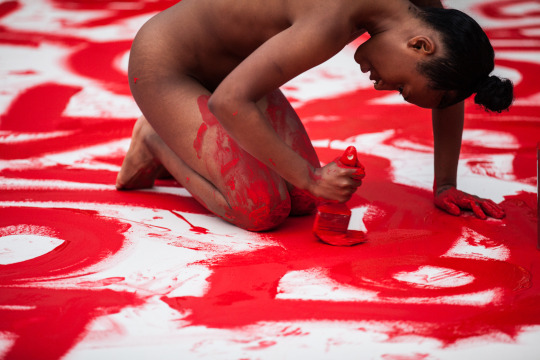
Dana Davenport, 흑인 (heugin)-black person,
2017,
Performance at Watermill Center,
Duration: 2hrs,
Photography by Maria Baranova
DD: Ahhh, that very familiar feeling of wanting/needing to prove your Asianness. It’s wild that even at a young age, we unconsciously understand privilege and where one is situated within that system. While I was obsessed with America for a bit, that phase was short lived. My desire to “prove” my Asianness is unfortunately something that has taken much longer to shake off. In a lot of ways, my art practice played a huge role in that process. It provided me an unrestricted space to express all of the messy, contradicting, and nonlinear feelings that I was moving through. Initially, it was a lot of bottled up anger, a desire to be embraced by Korean culture while simultaneously resisting it in fear of rejection. This is most clearly articulated in my performance piece “흑인 (heugin)-black person”. In this performance, I write the word 흑인 repeatedly on a blank canvas on the floor. Gradually, the task became more aggressive resulting in exhaustion, examining the arduous notion of performing identity. Have you found that your relationship to Korea/Koreaness has shifted over time? And if so, what was influenced these shifts?
While our experiences differ in ways, I’ve arrived at similar questions. “How do we begin to talk about these entangled and complex realities and relationships between Black and Asian futurity?” I definitely don’t have an answer but something that I think about a lot is where are Black and Asian folks are interacting the most and under what conditions? I feel as though, within America, store owner/customer settings are the most common spaces in which Black and Asian folks gather. Commonly, Asian-owned shops in Black neighborhoods. So, that’s where I’ve started and how I arrived at the beauty supply as a space to be reimagined. I didn’t know that you worked with hair in the past! I’d love to see some of that work. I’m really fascinasted by your research around chinoiserie patterns, as it’s something that I’ve seen in so many places in totally different contexts but never stopped to think about how it lived between these spaces (I also never actually knew what the pattern was called). I always viewed it as an “Asian-coded” artistic style (often seen on vases and such) but then would also see as a wallpaper in some preserved colonial mansion in Virginia and not think twice about the overlap between the two. This pattern is truly a chameleon! I love how you are thinking about the next lifeform of this pattern, how it can shape shift to reflect a new culture, a combined cultural aesthetic, how it can be flipped as a tool to mend wounds. As you said, it is our superpower to mend and create beauty out of the violence we and our ancestors have endured. When I began working with hair, I started with simple domestic objects. A vase, slippers, rug, etc. I wasn’t really sure why, I was just drawn to it. As someone who studied Photography in undergrad, I hadn’t really considered myself a “maker” and definitely didn’t have the tools at that time to create the sculptures that I’d envisioned. Out of the many ideas that I’d jot down (and often talk myself out of trying) creating a chandelier was one that stuck. In the Summer of 2018, a family friend, Dan, offered to teach me how to weld. That changed the game for me as far as the tools that I had to create. Initially, I was drawn to the chandeliers because of their ability to elevate a material that, when worn and activated by Black folks, is criticized as ghetto, cheap, fake, and unprofessional. As I’d hang them within my studio and home, incorporate them in installations, and hang them in gallery spaces, they began to take on a protective role, setting the tone for whatever room their in and requiring that viewers look up at them with appreciation and awe.
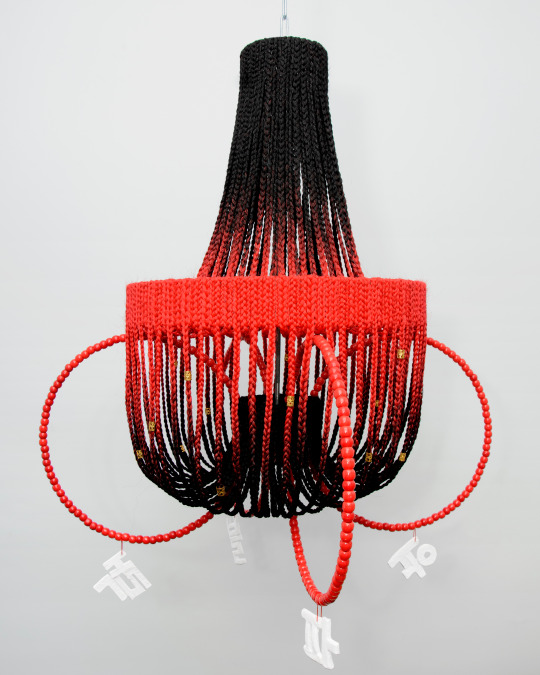
Dana Davenport, Box Braid Chandelier #3, 블랙파워 (beullaegpawo)-Black Power, 2021, 30in x 25in, Steel, plastic beads, modeling clay, synthetic hair from Hair Style 21 (Online)
DD: Years ago, I created a piece titled “Questions Not To Ask The Artist”. It was a large piece of wood (the size of a door) that listed several things I was simply tired of being asked by viewers of my work and visitors to my studio. I was at the ChaNorth residency at the time and I placed it right in the entry way to my studio. It served as a sort of agreement between myself and viewers entering my space. I find that the chandeliers function in a similar way. In “Experiments for ~Relaxation” which was performed at Gibney Dance (New York, NY)I was processing alternative ways of performing that weren’t focused on the production of labor. I wanted to push myself to explore what relaxation could look like for me. What does rest look like for bodies that look like mine? How do we achieve mental and physical relaxation? The creation of this piece was chaotic. I found that it was actually quite difficult for me to achieve a state of relaxation. This pursuit, the awkwardness of it became part of the piece. “Much Love” was a really beautiful collaboration with Jazmine Hayes at Swivel Gallery (Brooklyn, NY). Together, we created a space that spoke to restorative practices of protection and care, transforming the gallery into what felt like a domestic space. Reminiscent of your grandmothers home with pink painted walls and red carpet. A space where you were protected, where you could release, where we honored ancestral practices. The back room served as a meditation and alter space, calling forth generational repose and threading together themes of love, labor, ritual, self-care, and communal care. We interspersed our family photos and hung them throughout the space, connecting our families and our histories. Photography and family archives are really how we mark our time in this world, how we claim that we are here. We exist. It allows us to write our own narratives and have some aspect of control over how we are represented. Family albums impact the way that we connect with the memories that we hold and how we tell stories and pass them down. My mom always made it a point to ensure that we took a lot of family photos. Unfortunately, there are only two photos that my mom has from her childhood. When she was young, her home caught fire and with it went whatever photos her family had (which probably wasn’t many to begin with). On the contrary, my dad’s family has a huge archive of photos. I recently inherited a box full of them and have had so much fun flipping through, reading all the hand written notes, and asking my reletatives who certain people are. From that box, I found a photo of my mother, sister, and a few other family members, sitting on a brown couch at my grandparents house. It had to be from 1993 or so. The carpet in the room was a dark red was nearly identical to the carpet in the “Much Love” exhibition. That was a real treat to come across. I think that to be in solidarity with eachother we must first see eachother. Literally, seeing eachother in space and metaphorically seeing eachother within ourselves, within our histories, and as living, breathing, feeling individuals. It’s important to understand how the past factors into our realities in the present but it’s equally as important to dream of our futures. Care is conveyed when we hold ourselves accountable. When we place trust in eachother. When we can share space. For the past few years, language has played a large role in how I nurture myself and my own familial history. After years of feeling embarrassed for having lived in Korea for so long and not speaking Korean, I finally started taking Korean classes. I resisted for many many years, as I’d convinced myself that learning the language meant I was surrendering in some ways. Surrendering to a culture that rejected me and my Blackness. Honestly, I just had to get over that and understand that I can show up for myself by allowing myself the freedom to learn, to recontextualize, and to grow in this way. I’d like to ask you the same question. It feels like a beautiful note to come to a close on. How are you thinking through methods of care as a tool to nurture critical dialogue around Black and Asian futurity and solidarity? What care is required to nurture yourself, your history, and your familial lineage? And how does photo documentation and family archiving contribute to these forms of storytelling?

LaRissa Rogers, My Body Is The Architecture of My Every Ancestor, 2021. Performance, 1 hr 15 min. Performed at the Bridge Progressive Arts Initiative. Photos taken by Chan Williams.
LR: You begin your response by asking if my relationship with Korea/Koreaness has shifted over time, and I think it has. The work is a direct timeline of that shift. The Latasha Harlins case was my first stepping stone. The interaction between Soon Ja Du and Latasha Harlins speaks right to your articulation of what solidarity requires– for us to see each other individually and collectively within shared experiences and histories. Within Latasha Harlins’s and Soon Ja Du's interaction, there were fundamental misinterpretations of the “other,” and those misinterpretations are based on our system that can only survive by pinning us against one another. In “We’ve Always been here, Like Hydrogen, Like Oxygen” I directly speak to this in some of the text overlaid in the video which reads, “you and I are connected.” When I wrote it, I was thinking of Latasha Harlins but also Soon Ja Du. This conundrum reminds me of a quote I read from Scott Kurashige that states: "The 'model minority' stereotype isn't meant to define Asian Americans. Rather, it's meant to define African Americans as deficient and inferior to white people by using Asian Americans as a proxy...It was never an accurate portrayal of Asian Americans." Though I had discomfort, sometimes anger, a deep sense of loss, and a longing to be more connected to my Koreanness I needed to recognize within myself why I felt tension and separation. I use my art as a way to heal and as a means of owning my Koreanness while acknowledging my positionality within it as someone distant from the place and culture. Coming to terms with this was something I had to get over and required me to be soft with myself. But care is hard! Often we forget that. Care is a lot of work. Sitting within the pain, within the hold – as Christina Sharpe would say is not pleasant work. That is what I am trying to do with my work. It is also how my relationship with my Koreanness shifted. I am no longer preoccupied with proving my Koreanness, legitimizing it, or ignoring it, which I did for many years. Embracing and attempting to learn my history and heritage-- one I also feel does not fully embrace me at times– is an attempt to understand my mother's experience, my experience, my father's experience, and the histories of entangled experiences. It is not an either-or. It is a both and. A hybrid approach that has allowed me to reject categorization and politics of authenticity that felt restricting and violent.
It's interesting to hear you speak on the few images your mother has of her childhood because similarly my mother only has a couple of images left from when she was a child in Korea. Her father discarded most of them when she was young. Alternatively, my grandmother on my mom's side made many photo albums. When she died, the photo albums were gifted to us. In my last year of undergraduate school, I remember going through all of the photos for the first time. I would ask my mom about members of the family that I could not identify. This was a way to connect to my family and the family my mom adopted into. My grandma also loved embroidery, and every so often when I was going through the box of photographs I would find notes on the back of images, and embroidered handkerchiefs with quotes or rhymes. It was really surprising for me to discover these notes because I would never classify my grandmother as a jokester. But, a lot of the images had inside jokes written on the back of them. It was an entirely new way I understood my grandmother. By 2019 my grandmother had passed away, but I had a show “Invisible Weight” where I used her embroidered handkerchiefs as a mode of rememory and collaboration.
My great-grandmother was also a great archivist, though many family photographs were lost in a house fire.
Growing up, my mother was very good at documenting our lives. My siblings and I have a “life book” that tells our childhood story until high school. Many photos in my “life book” show up in my “Brown Paper Bag Series” from 2019. This book includes adoption photographs, songs, family vacations, holidays, and images of loved ones. Looking back, this was another present my mother gifted the family as a healing mechanism. She continued a labor of care that women in my family had done for generations. She made sure we documented our lives so we could feel seen and know where we came from. How does one memorialize the everyday? I would argue, through family archives – visual and embodied.
Solidarity requires grace. I have eight siblings, and most of them are adopted. Despite adoption, my family is close. Our home was also a foster home for many years. People cycled through, all of who came with their own “baggage.” I learned at a very young age that communing with people from different experiences and backgrounds requires empathy and grace. Grace for others, and yourself. Grace softens. Grace allows us to listen and hear, to nurture and understand. Grace creates space for everyone's story, history, and experience. In order to create new futures we need to acknowledge the past is not the past and difference is inevitable. Yet, through acknowledgment and accountability, new ways of being can emerge. In the words of my mother, care and repair requires one to "die to self."

Dana Davenport (b.1994) is a Korean and Black American interdisciplinary artist raised in Seoul, South Korea. She is currently based between Los Angeles and New York City. Her work shifts between installation, sculpture, video, and performance. Davenport's work has been shown throughout the United States and internationally including Gibney Dance, New York, NY; Watermill Center, Water Mill, NY; NYU Skirball, New York, NY; Brown University, Providence, RI; Swivel Gallery, Brooklyn, NY; Cultural Center Recoleta, Buenos Aires, AR; and Seventh Gallery, Melbourne, AUS, to name a few. Davenport is currently a 2023 Center For Craft Fellow and Bandung (MoCADA + A4) Artist Resident. She was selected for the Recess Session Residency in 2021, and received the 2018 Chashama ChaNorth Fellowship. She co-organized Free Space, month-long programming at Miranda Kuo Gallery in 2018, and is the founder of Dana’s Beauty Supply.
www.danadav.com @dana_dav
LaRissa Rogers (b. 1996) is a Black and Korean antidisciplinary artist raised in Ruckersville, VA. She is currently based between Virginia and Los Angeles. She holds a BFA in Painting and Printmaking and BIS in International Fashion Buying from Virginia Commonwealth University. Rogers has exhibited and performed in institutions such as Frieze Seoul (Korea), Documenta 15 (Germany), Fields Projects (NY), 1708 Gallery (VA), Second Street Gallery (VA), Black Ground (Colombia), W Doha (Qatar), The Fronte Arte Cultura (CA), LACE (CA), Grand Central Art Center (CA), and the Museum of Contemporary Art (VA) among others. She received the Visual Arts fellowship at the Virginia Museum of Fine Arts (2022) and the Black Artists and Designers Guild Creative Futures Grant (2022). Rogers attended the BEMIS Center of Contemporary Art Residency (2022), Black Spatial Relics Residency (2022), and SOMA (2019), among others. Rogers is currently pursuing her MFA in New Genres at the University of California Los Angeles.
www.larissamrogers.com @larissa_rogers
0 notes